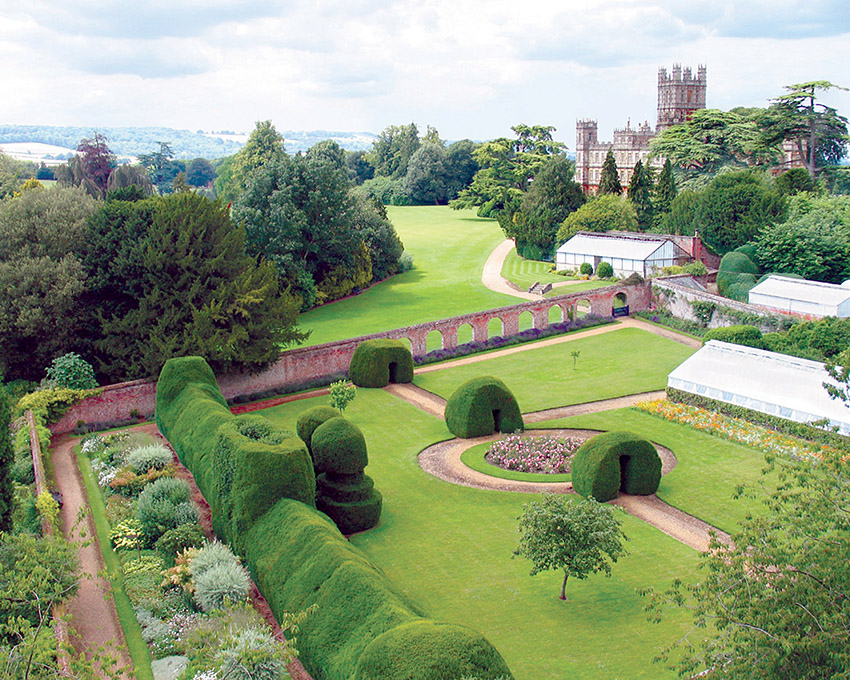
The beginning of our records state that for some 800 years, the Bishops of Winchester owned Highclere. Lacking today’s supermarkets and grocers, the gardens played a vital role in daily life. Fruit, vegetables and herbs were grown close to the buildings whilst further afield, pastures provided fodder for sheep, cattle and horses, while crops such as oats were farmed on the arable land on the surrounding hills, much as we do today.
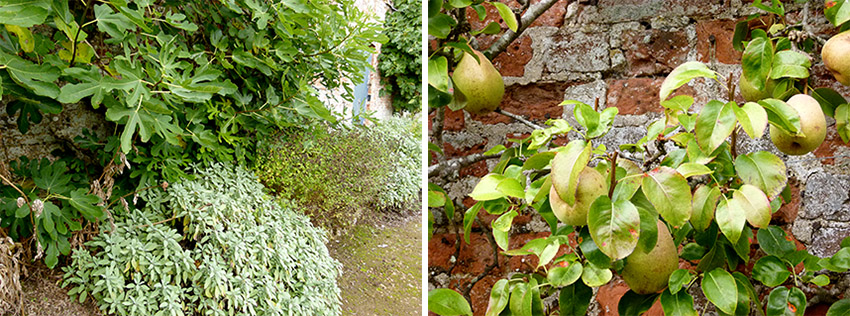
Figs, sage and pears against the top wall
Later, during medieval times, the walled garden was built on a south facing slope to the south east of where the Castle stands today. The tall walls kept the wind out and the bricks retained warmth far better than stone. Records testify to the different types of pear and apple trees grown within its walled protection plus a description of a “frost gate” opening out at the bottom into an area of old woodland. This carefully chosen aspect meant that more tender plants could be grown, warmth rising back up the slope, whilst the ‘frost gate’ in the bottom wall allowed (and still allows) the cold air to escape.
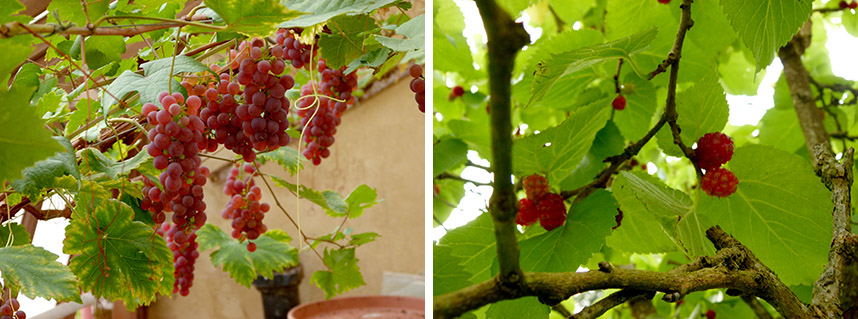
We now have a greenhouse as well for grapes. The mulberries are on on the trees in the middle of the lawns
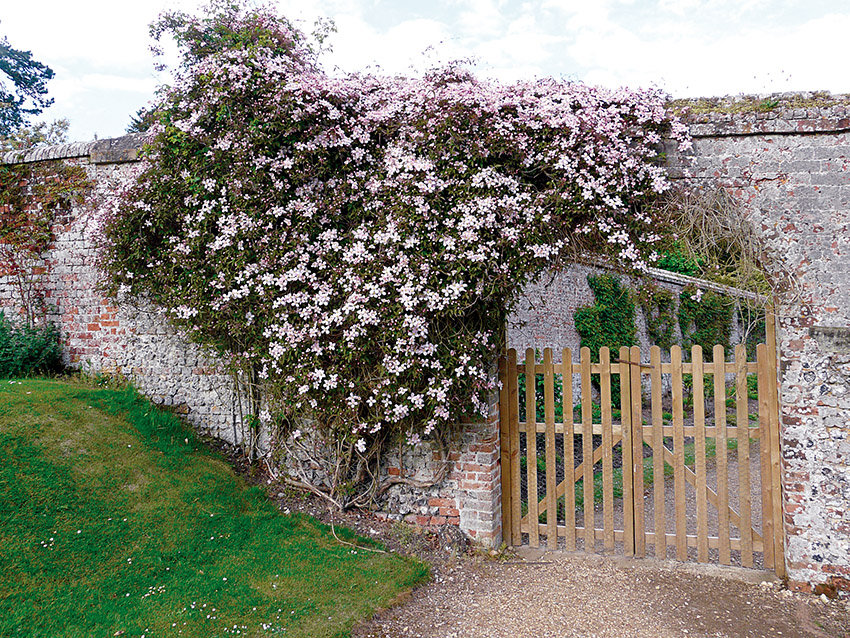
The gate covered in clematis
It may also have served as the location for the physic garden. Such a garden was central to every medieval infirmary and it would be unlikely for a community such a Highclere not to have had one. Sage, hyssop, rue, chamomile, dill, comfrey and cumin … All typical plants for such gardens and ones that are easy to grow on the chalk and alkaline soils found here. It is interesting to see how many of these were used for digestive complaints. I remember reading somewhere that it was not uncommon for medieval soldiers returning from battle, mentally shattered by all they had seen, to be offered work in monastic gardens and given herbs to encourage them to sleep. Nothing much changes in the turmoil of today …
In fact, even earlier, the Ebers Papyrus from ancient Egypt c.1500 BC recorded over 850 plant medicines, including fennel and linseed which we still grow here, plus notes on treatments for trauma. Indeed Tutankhamun was buried with garlic and onions to help his respiratory system and digestion in the next life.
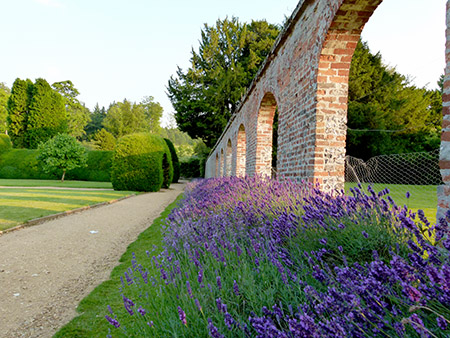 Walking through the old walled garden today you can still see ancient foundations, the shadow of unused doors, coping stones which just extend out above the crab apples, figs and vines trained up the faded brick walls. Long beds of lavender grow in abundance, whilst mulberry trees and quince stand amidst green grass. Today, we have also planted roses and other flowers for scent and beauty which perhaps also aid health by encouraging us to smile and feel happy.
Walking through the old walled garden today you can still see ancient foundations, the shadow of unused doors, coping stones which just extend out above the crab apples, figs and vines trained up the faded brick walls. Long beds of lavender grow in abundance, whilst mulberry trees and quince stand amidst green grass. Today, we have also planted roses and other flowers for scent and beauty which perhaps also aid health by encouraging us to smile and feel happy.
The Monks’ Garden, however, is a little distant from today’s Castle, down an incline and along a gravel path. Reflecting on the history of herbs grown here we have, in recent years, created a new, symmetrically planted herb garden within a beech hedge near the Castle tearooms. In the middle is a modern sundial on which is inscribed: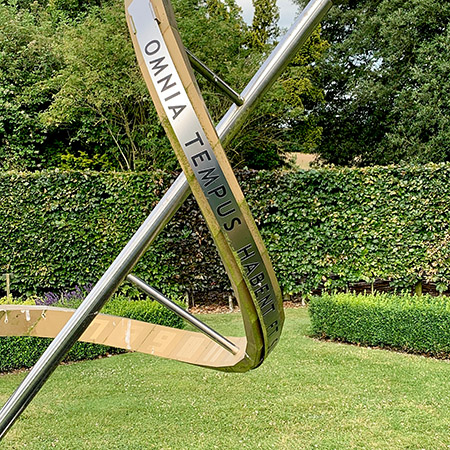
‘Omnia tempus habent et suis spatiis transeunt universa sub caelo”
From Ecclesiastes it translates as “To everything there is a season, and a time to every purpose under heaven”.
Philip has worked in the gardens at Highclere for over twenty-five years and in particular he helps me look after this area, planting a traditional selection of herbs, all of which I very much enjoy using today. There is plenty of sage because, apparently, if you grow plenty of sage, you will never grow old. We also have sweet woodruff to deter moths, sorrel which aids digestion and liver problems, lavender for sleep, rosemary to promote energy and fennel and chamomile for teas.

Views of the healing herb garden
This is not just old fashioned “sage” advice: plants form the basis of around a quarter of all modern western medicines. All must be treated with caution as different parts of the plant may be toxic if used improperly. For example, daffodil bulbs are highly poisonous, yet one chemical within it, galantamine is now licensed for use to help Alzheimers.
Mahatma Gandhi said “To forget how to dig the earth and tend the soil is to forget ourselves.” Most of us have the space for a few pots of herbs at least.








 Instagram
Instagram
MY DEAR LADY CARNARVON,
LIVING THE DREAM. LOVELY HERB GARDEN.
VILA ALEMÃ
RIO CLARO SP
BRAZIL
Please do -live the dream!
Dear Lady Carnarvon,
What a beautiful herb garden.
You describe it so beautifully.
I am visiting Highclere Castle on August 8th, and I hope to see this gorgeous garden.
This is my very first visit to your lovely home. I live in NYC, and thankfully I’m surrounded by Central Park.
I am saving my money I will be 70next year I can’t wait to visit I love the books and history and especially the herb gardens,thank you for sharing your wonderful life with America and all over the world,I hope to walk along your peaceful herb gardens,the castle is a dream come true to watch on tv. You and your family have taken on an enormous task of restoring and maintaining this beautiful castle,blessings to you all, Sue Wood,,small country town of Woodbury, Ct
I hope you come here too – we are trying to put out our ticket dates earlier so you can book flights earlier which are therefore good value.
Stunning beauty and useful plants all in one! Absolutely lovely gardens!
Beautiful meander through the herb gardens with you
Thank you
I recently found your blog and love it! My grandmother had a walled garden in Ireland. As I child I remember going out with her to pick apples for a tart and dig potatoes for the dinner. She would tell me all the names of the flowers and herbs. They are memories I hold dear even today!
We must still do as our grandmothers did!
Dear Fiona,
Tatiana kindly included all 5 of us for the Gold Star outing post our Christ Church “lessons. ” What a treat to not only have a proper English lunch including pasties, but a personal tour including family anecdotes by you. Lucky for those who were on the tour with us to glean all of your charming and insightful remarks. As I mentioned, I was at Highclere late May for a tour and tea with a New Orleans friend so it was a double dutch treat to have an encore with you. When convenient, kindly send me your email as I want to write you on a personal note on something I discovered in the Egyptian exhibit which I had not seen the first time. I am taking your Highclere Gin as a hostess gift to our family’s closest English friends at Chillingham Castle in Northumberland. Sure to be a hit
It was a fun afternoon and thank you for promoting the gin!!!
And to think the Plantation I volunteer at was built in 1791. A youngster compare to this.
We are definitely all various ages ..
Dearest Lady Carnavon,
The depth and breath of your knowledge is astounding, and matched only by your gracious humility. Your posts are the highlight of my every week.
Carolyn
Temecula, CA
You are kind – I feel lucky to live somewhere where I just discover and understand a little better every day…
What an amazing blog. I’m a history major in college. Story’s like this brings things into perspective that the castle has such a great story beyond most could even imagine. Thank you Lady Carnavon.
Thank you
I’m suddenly struck with a need to start rereading / rewatching Ellis Peters’ Brother Cadfael series for it’s accounts of using plants not only as medicine but also as a means of solving mysteries.
Murder mystery here next!!
Lady Carnarvon,
Once again you have provided a lesson from medieval, indeed even further back in history, the the wise ‘sages’ who knew what means were close by for health and healing. We owe so much to earlier times, yet we have the tendency to dismiss these findings based on what we think is our more enlightened vision. How we do ere! Fortunately there is a medical community which appreciates these long ago lessons and gives new hope to many whose sufferings are not otherwise solved. Thank you.
Martha Glass
I think life is a mixture and at the moment I sort of feel we are mismatched with our world…
Dear Lady Carnarvon,
You live in such an amazing place. Your knowledge of the history of is equally amazing.
Best,
Marla Dunning
I think Jack of all trades , master of none also springs to mind!
I absolutely love learning about all of the various gardens and plants grown at Highclere. Thank you for sharing this treasure with your devoted readers.
Lady Carnavon
I enjoy your blog. I love your knowledge of the history that surrounds you. Myself and 5 others will be visiting Highclere on Sunday July 21. We are beyond excited to experience the beauty of the castle and grounds.
Regards,
Mimi Ragan
I do hope you enjoy your visit – the weather looks to be fair.
I am so grateful to you. You bring me there as you describe beautifully your world and all it’s surroundings. Thank you Lady Carnarvon ♥️
Thank you
Good Morning, Lady Carnarvon,
As I always LOVE reading your webpage, I love even more the beautiful pictures and the hills and landscape that afford all of your readers.
Sense, at one time or another, we were/ALL Downton Abbey watchers, it is nice to know that all the landscape really do exist.
It is always a PLEASURE writing you a short note form time to time, and returning my thoughts on your articles.
Regards,
John Roberts
Amherst, U.S.A.
You are too kind.
Thanks for this blog post today, I really needed it. Love horticulture and garden speak, especially after having triple bypass surgery. Rebuilding life is like replanting a garden, everything new must be obtained and tended. Love the pictures of your gardens so well tended and crafted. Such history abounds in loveliness. Betty
I wish you a speedy recovery.
Dear Lady Carnarvon ,
Thank you for the Herb lesson and “Sage” advice.
We ARE in a mismatched world.
Wouldn’t it be great if everyone just tended their OWN gardens and came out in the Spring, to trade seeds, and Fall, to share their bounty!
What a wonderful idea!
Dear Lady Carnarvon,
Thank you for sharing your lovely gardens.
Regards,
Jane Kitchen
The gardens and architectural elements are just beautiful! Thank you for sharing your home. I love reading everything you write and look forward to it every week.
Even if you don’t use medicinal herbs, Just looking at a beautiful garden soothes the soul. Your garden did that for me when I was there. Thank you.
You are absolutely right. It is so important to take time out from our busy lives and just be.
Dear Lady Carnarvon,
Given the subject matter of today’s blog, I very much enjoyed reading your “sage” advice.
It’s interesting how a word can have different meanings, depending on its context. For example, as an adjective “sage” can mean wise, prudent, perceptive, discerning, insightful, etc.
As a noun, “sage”can mean an herb or a plant. Sage was once used to help childless couples conceive, and of course is associated with wisdom and as noted by your good self longevity. It also was used magically to honour weddings and to ensure domestic harmony.
Alternatively, also as a noun, it can be used to describe a person of great/profound wisdom. A sage generally has the wisdom that is sought by philosophers.
And then of course, there were the seven ancient Greek sages renowned for their wisdom: Thales, Pittacus, Periander, Cleobulus, Chilon, Bias, and Solon.
This can all be very confusing unless one takes sage advice and stops writing any more on this subject before all manner of confusion breaks forth.
I will therefore conclude by thanking you for sharing the beautiful photos of Highclere’s lovely gardens and yet another enlightening blog to start our week with a smile.
Yours faithfully,
Jeffery Sewell
Beautiful gardens at Highclere, and beautiful for good health and wellness, too. I should love to stroll by those lavender shrubs, they are so lovely and I imagine the scent is so tranquil! Is this the best time to see the lavender at Highclere? If so, besides planning for a September or Fall visit, it seems I may have to also come in the summer to Highclere. Thank you for this blog and for taking us on such a lovely walk through the gardens!
The lavender is out at the moment so June/July is the best time.
Dear Lady Carnarvon,
Thank you for yet another wonderful piece about something so close to my heart. I have loved herbs since I was a little girl, particularly lavender. I have lots of it, as well as rosemary, parsley, lots of sage, thyme, basil and chive which I use almost daily this time of year. I cut all that I can in the autumn, to freeze, and use with great joy (and memories of summer), in the winter. I dress my Thanksgiving turkey with herbs from my garden. Sharing washed bundles of different herbs with friends and family gives me great happiness. It truly is a glorious part of all that surrounds us!
I have lots of photos of your magnificent lavender borders from one of my visits to Highclere. I lingered for a bit, watching the bees enjoying the gorgeous and fragrant blossoms. I’m sure many of the herb flowers are put to good use by your bees in creating the delicious Highclere honey.
I will look for the Monks Garden on my next visit.
Best regards,
Charlotte Merriam Cole
Our bees seem to love all of the purple flowers in the gardens.
It is a treat to read your blog, which I only recently discovered after noticing your posts on Instagram. Thank you for taking the time to share.
Thank you
Dear Lady Carnarvon,
The minute I opened the beautiful photo of your herb garden, I immediately remarked “O My!”
It is such a magnificent area, and I can definitely appreciate everything in it, and why it’s there.
To be able to work the land is a very gratifying feeling, and my hat goes off to all who have kept your ‘gardens’ looking and producing so well for so long.
I especially appreciated your information about each of the items that bring so much help, and how to be careful of each that are potentially harmful.
Very nice blog!
Regards, Jane Hrabak
Thank you
Absolutely lovely gardens
I now live in an apartment, and you have encouraged me unknowingly to get a few herbs in pots I can set on my patio. This will be my mini-garden. I love your blog for this week!
I grow herbs in pots on my kitchen windowsill too.
Lovely posting about the herb garden- mine is being re-established slowly. Another #storm has just blown through and the rest of #hurricane_season looms over us. Having grown up on a sustainable ranch, it is so comforting to know the practices continue. Your posts remind me that I’m not alone. My mother died yesterday; she planted gardens – both vegetable and floral. Quite a legacy! Thank you. Enjoy your week.
Ida
I am so sorry for your loss. I expect you have some wonderful memories of your mother and her garden.
Dear Lady Carnarvon,
I am send this to my gardening group! Thank you! (They might even think I know much more about gardening than I actually do!)
Barbara Wendell
I so enjoyed the gardens last September! I followed the road less traveled, wandering into the gardens. Most of the activities were around the castle. I was joined by a couple of people, soon loosing them as I found the secret garden. I then traveled into a meadow enjoying the exquisite joy of oneness with nature. Thank you for sharing the gardens history.
The sheep lady from Colorado.
The first picture today is amazing! Such manicured gardens! Our own garden is full of herbs that I use in cooking all summer – but doesn’t look anything like yours! Love your stories about history – if only we would learn from it – I heard that the medicine men/women were murdered when the missionaries were here in CA so that they would not hold any power over the indienous people they were trying to convert. During this time all the plants medicinal use was lost and had to be learned all over again. Just sitting and looking at plants gives me peace of mind – Take care and hope to see you in August!
Dear Lady Carnarvon,
How wonderfully interesting! Thank you for teaching us more about the medicinal herbs and plants. It is so very interesting. I am seeing a slight trend to turn back to the natural way of healing. I must say I think it is better for us rather than the synthetic drugs of today.
I was so very interested to see the aerial picture of Highclere. I had not viewed it from that angle before. I see now that there is still more to explore whenever we can return to England. I have not seen that part of the estate. It is so beautiful. I really love the ancient walls. They seem to stand as sentinels, guarding and protecting the Castle. We missed seeing the large Sundial. too. Is it available to visitors or is it in a private part of the estate? Did Capability Brown design all of the landscaping at Highclere?
Thank you for sharing. I look forward to Mondays because of your blog. We are in the midst of a major renovation project. It is tiresome after over a year of being torn up. I have not been sleeping well, so my Husband has been letting me sleep late so I can “get caught up” on sleep. Yesterday I happened to wake up early (for me). I looked at the time and my first thought was, ” I wonder if Lady Carnarvon’s blog has been posted yet”. So, I got up and dressed and went out to turn on my computer to see if it had been posted yet. My husband was a bit surprised to see me, knowing I had not slept well. I told him what prompted my early rising. Then, he told me it was Sunday, not Monday. I was so eager to read your blog that I didn’t think about what day it really was.
Thank you for that!
How wonderful that you set your calendar by my blog!
Dear Lady Carnarvon,
I love the lavender garden!! I have a big lavender flower pot on my terrace at the moment not much to do a little gardening, but it is mine! I used to have a lot in my backyard when I had a house.
And sage right for never getting old? I think I’m going to plant some next year for sure! (c ;
Salutations!
Chantal
Montréal, Canada
I do have a lot of sage – it is delicious and like the Italians I sometimes simply panfry some leaves in butter and a little flour and they are a canapes – the ones of course I haven’t eaten…
Clearly important to plant the sage, lavender and rosemary!
This is “b’sheret” (the Yiddish word for “meant to be”) that you posted this today! I have long wanted to learn about medicinal herbs and plants, but living in the heart of Los Angeles in an apartment, it is hard to actually have my own garden. I have friends who live in rural Canada and who are very involved in herbology (is that the word?)…and I am so envious of them. However, just the other day my husband came across a gentlemen who offers “herb walks” in the botanical gardens and other wild spaces near the city. And now, you have posted this! The universe is telling me I need to learn about herbs and plants. Thank you.
To be with out world and environment..
Two of our plants in South Louisiana survived Hurricane Katrina, which almost wiped New Orleans off the map leaving the area under water for an extended period. A beautiful climbing rose has been named the Peggy Martin rose because it survived in Peggy’s New Orleans garden. A plus is that it has no thorns. The other is a lovely Monrovia iris now called the Katrina iris.
We have a boutique hotel in Baton Rouge which is growing herbs on it’s rooftop. These are showcased in the hotel’s restaurant.
I was in New Orleans for a talk in February – great city and the food ….
Dear Lady Carnarvon,
I love reading your blog!
Every week I look forward to it. I’m coming across the pond from New York City, and will be at Highclere visiting for the very first time. I’m been to London, but never went out to the country, and I’m looking forward to see everything you always write about. Now this herb garden. On August 8th I am going to be walking up the path to the most incredible Castle, and beautiful grounds.
Don’t laugh, but I plant herbs in a window box outside my kitchen. I live in a apartment in the city, and thankfully I can walk through Central Park to see plants, flowers, etc.
I should be there on the 8th..
Lady Carnarvon:
We recently had the pleasure to visit the castle and tour the gorgeous gardens you reference in your blog. It was truly the highlight of our trip to England. We were so appreciative of the time you spent to greet all of us on the tour and provide some insight into the history of the estate and how you currently manage the property. Thank you for opening your beautiful home. I enjoy your blog very much and wish you continued success. As an avid gardener, I know first-hand gardening is therapy. Just the act of it improves your mental and physical well being. Happy planting.
Thank you Lisa
Another great and inspiring blog- I LOVE Mondays !
Thank you !
Thank you for another awesome blog. At the ripe old age of 78 I am a relatively new gardener(six years) I am trying to “catch up”. I now have a small garden with some of the plants you mentioned and I have now caught up with Cicero who as you probably know said “If you have a garden and a library, you have everything you need.” I have a plaque on the wall in my office with his words. It reminds me of how blessed I am to have both.
And to top things off my new issues of Britain and The English Garden just arrived.
Thank you again and have a wonderful week.
Lin Miller
PS This week end my wife and I fly to Southampton for a 12 cruise with stops in England, Scotland, Wales and Ireland. It will be lovely to be back in your part of the world.
It sounds a good summer!
We are so dependent on artificial means to remedy our ailments in the form of drugs. Thank you for reminding us of nature’s way of treating every day symtoms. Not only are your herbs helpful, but very pretty in gardens. I enjoyed wandering through your garden five years ago. I wish we had time to stroll more leisurely in the beauty of your estate, so much more to see and appreciate.
Thank you!
We’ve been fortunate to spend many summers since the 1990s on research sojourns at Clare Hall of the University of Cambridge, during the most recent 2 of which we treasured visits to Highclere. One (2015) was in the teeming rain, the other (2016) for lunch and a quick visit enroute to Cambridge from a Montecute-area weekend, so the walled and herb gardens remain for next time. But once, walking to town through the magnificent Clare College gardens, we saw the gardeners cutting back lavender borders on the entry path late in August. They were happy to have me take an armload—they were just composting it—so cousins and friends received Clare lavender sprigs in sachets I made. I’ve just renewed our HHA membership for 2020, so we’ll hope to return next summer. As we “right-size” for the next chapter (a move from Philadelphia to be near family in Cambridge, MA), your posts are always inspiring and energizing for the week ahead.
Dear Lady Carnarvon: Thank you for sharing the history of your gardens and the stunning photos. Your blog is so interesting and uplifting. My cousin and I visited Highclere on July 7th. We enjoyed our tour of the house and the Egyptian exhibit, then spent the afternoon exploring your beautiful gardens.
Regards
Lorraine
Dundas, Ontario
Canada
Thank you for visiting us –
* * *
Thank you Lady Carnarvon!
Lovely blog and lovely gardens!
My sincere appreciation and admiration!
* *
Thank you!
A very beautiful garden!
Thank you!
Dear Lady Carnarvon,
The gardens are beautiful. Every Monday I look forward to reading your latest blog post. It’s like an unexpected gift. You don’t know what is inside until you open it. What a treat your thoughts and words have been for me.
In passing you mentioned quince. This fruit was introduced to the American colonies in 1720 however, these days it seems to be almost forgotten here in the states. I was wondering if it is like an apple or pear? Is it eaten raw or best eaten cooked in a pie for example? When you fry sage in butter is it served over pasta? Dear lady, you have pricked my curiosity once again. Thank you!
Here’s hoping you have a wonderful week.
Mary Watkins
West Memphis, Arkansas
Quince is a large pawpaw shaped fruit – yellowish in colour – I think there is a recipe in “At Home at Highclere” which is about recipes and stories from here..You do need to cook quince – it has a very pretty pink colour whether you could poach, roast it or just include in stews. They do need some sugar as you poach them – quince jelly is delicious.. I have just planted 3 more quince trees , just outside the herb garden as they are then quite near the kitchens !
It has in the past always been highly valued.
How interesting. Thank you!
Beautiful garden, including medicinal plants !
Looking forward to visit Highclere.
All the best .
Isn’t that the truth that “to everything there’s a season…” We live in a highly populated area so we don’t have much of a garden. Last year my husband said that he was going to grow cheery tomatoes on pots and placed them on the deck. I objected because I knew he was not going to take of them, but he insisted. At the beginning he was very diligent about his tomatoes, but as weeks went by his efforts came to a halt and the next time he checked, the plants had died our of thirst. When he mentioned that this year he wanted to try growing tomatoes again I just looked at him and then he changed the subject. Your gardens are beautiful!
What about sage ?
We get a lot of sun. Will sage survive?
It is does well in Italy..worth a try?
Beautiful garden. I don’t recall it being used in the TV series.
Some corners of the gardens were used ..
Amazing place! I have to visit it again.
Living the Dream vicariously through you!
I can’t wait to visit!♥️
Dear Lady Carnarvon,
We have enjoyed your blog and have just booked to visit in October, we are travelling from Tasmania. I was born in Berkshire and have loved the countryside; especially historical homes and gardens from a young child.
Looking forward to our Highclere visit. The photographs of the estate and gardens are truely amazing.
Kindest regards,
Karen Allen
Scottsdale
Tasmania
Thank you -October is a beautiful time of year!
Estimada Lady Carnarvon: muchas gracias por sus interesantes comentarios respecto de la historia y el jardín. Soy docente de la carrera técnica de jardinería en la Universidad de Buenos Aires y en lo personal me encanta la Historia de la jardinería y el paisaje. Mi curiosidad me lleva a indagar permanentemente y a ilustrar mis clases. Es apasionante ver cómo se ha desarrollado el pensamiento a lo largo de la historia y cómo esas ideas se plasmaron (en éste caso…) en los jardines de todos los tiempos.
Saludos cordiales.
Gracias, creo que los jardines nos dan raíces, no solo las plantas!
Thank you again for another fascinating blog. As a city dweller, I don’t think much about kitchen gardens or herb gardens, but I do see the need for it. I think I will get a few pots of rosemary and fennel – then place them on my kitchen table where they will get some sun.
I love pots of herbs they are at the centre of my cooking too
Dear Lady Carnavon went to see the film Downton Abbey yesterday and absolutely loved it, seeing all the familiar actors taking their parts again was a real joy which reminded me so vividly of my visit to your home a few weeks ago unfortunately when it was raining profusely. I did manage to spend a short amount of time in the garden though (I teach flower arranging for new flower arrangers for U3A) and saw a stunning clematis on the wall just by the lavender (which was going over somewhat which had obviously been glorious earlier in the season…!) when I then saw two of the same most beautiful pinky clematis plants with masses of flowers, which I had never come across before on the wall just before going left into the white garden…the clematis flowers had 4 tiny petals almost in the shape of a cross with a yellow ‘fluffy’ centre so searched everywhere for the label which I didn’t come across… I fell in love with this beautiful clematis and try as I might have not been able to find it anywhere… I truly would be so grateful if you could let me have the correct name of this clematis if possible please as I would truly love to have one in my garden…this would then continue to give me a very happy memory of Highclere Castle and my visit…thank you
one Clematis just by the gate into the Monks Garden is Clematis Montana – it flowers profusely ..it may be that one?